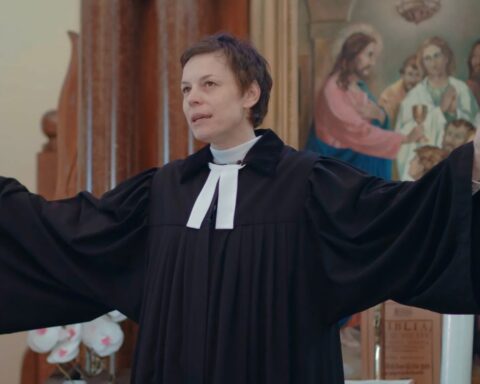Grace Jones: Bloodlight and Bami
(UK/Ireland, 115 min.)
Dir. Sophie Fiennes
Grace Jones: Bloodlight and Bami is the only documentary I’ve ever seen that cites a hat designer in its opening credits. The title card is well earned for hat master Philip Treacy, since Grace Jones brings a fierce chapeau game in nearly every scene of Bloodlight and Bami. Director Sophie Fiennes finds a heck of a subject in the enigmatic style icon from Jamaica, and the range of hats and headgear is just one facet of her singular presence. The film also credits a corset designer, if one wants a sense of how fashionable is this diva doc.
The subtitle of Bloodlight and Bami refers to a music studio recording light and a Jamaican cassava flatbread, respectively. While the doc features Jones’s musical career and family life prominently, Fiennes really offers a three-pronged approach to her depiction of Jones. One prong is an intimate 2016 concert staged specifically for the film, another follows Jones back to Jamaica to observe stories of her family and heritage, and the third facet of the film portrays Jones as a working diva as she readies her next album.
The concert sequences play out in lengthy performances of individual songs with which Fiennes divides the film into unofficial chapters. (The director is also the film’s editor.) Jones is a wild diva while performing songs like “Love is a Drug” to a sweaty disco beat. She shows off her vocals and church roots when belting out “Amazing Grace” to a synth-pop beat. The songs bring with them ample costume changes and new hats, including one cool bowler sequined like a disco ball that reflects green lights projected onto Jones’s head from above the stage. The conceptual production design by the late Eiko Ishioka (perhaps best known for her Oscar winning costume design for Francis Ford Coppola’s Dracula) make the concert a spectacular showcase for Jones’s enigmatic and electrifying stage presence.
Scenes with Jones’s family in Jamaica are down to earth tours of the star’s hometown and roots. Interviews with family members, neighbours, and friends don’t reveal too much about Jones, but they afford a sense of her origins, character, and the distance she’s travelled in her career. Views of the Jamaican countryside offer a fine retreat from the grind of showbusiness as Jones swims in the lake and enjoys the sunset, just as any viewer might find comfort in a return home or a weekend retreat.
The footage of Jones, the diva, shows the star slurping oysters and sipping Cristal in Paris. She prepares a new album and puts herself through the grind that makes the return to Jamaica so rewarding. One sequence, a performance of “La Vie en Rose” on French television, sees Jones put up with a sleazy staging of the famous Piaf song and then sass out a producer backstage for making her feel like a madame running a brothel as she sang surrounded by beautiful girls dancing in skimpy lingerie. There’s a lot of blood and fire in this thread of the film and Fiennes’s footage illustrates that Jones has seen it all in her road to fame.
Fiennes draws upon a decade’s worth of material she amassed following Jones, so the range of coverage and snippets of Jones’s life is impressive. By consequence, however, the quality suffers with older and grainier digital footage contrasting garishly with the more cinematic concert scenes.
Fiennes cuts the picture très chic by eschewing music doc convention of talking heads and greatest hits montages. The director barely makes an effort to explain Jones’s body of work in terms of music, movies, or modelling and the film is better for it. The only album covers one sees are cradled by autograph-seeking fans. There isn’t any footage from Conan the Barbarian or A View to a Kill, nor any glamour shots from the archive. Instead, we experience her energy, power, and vitality. Fiennes doesn’t try to put the icon into a box, but instead offers enough material to provide a sense of what Jones is like as both a person and a performer. Bloodlight and Bami is not a portrait of Grace Jones but an impression of the iconic diva. It’s an enigmatic thrill.
Read more about Bloodlight and Bami in our chat with director Sophie Fiennes








